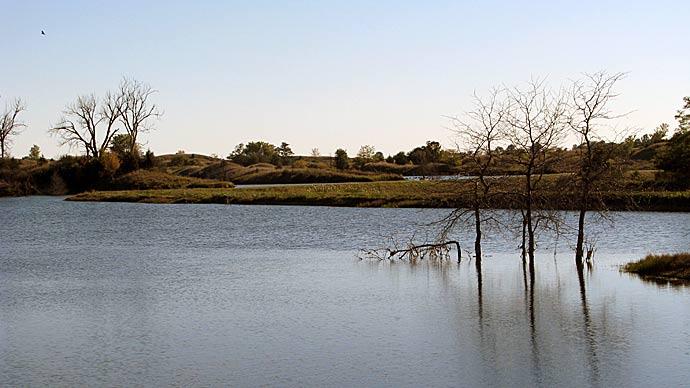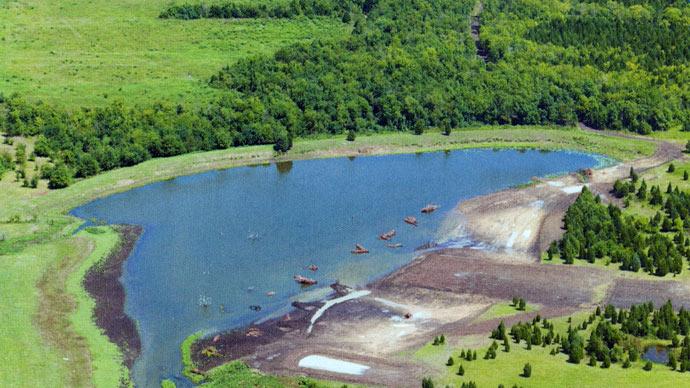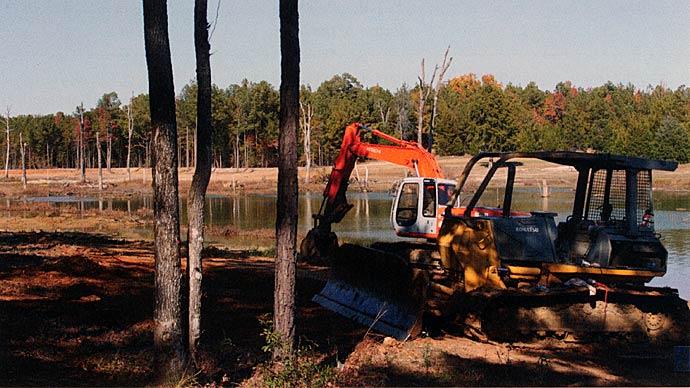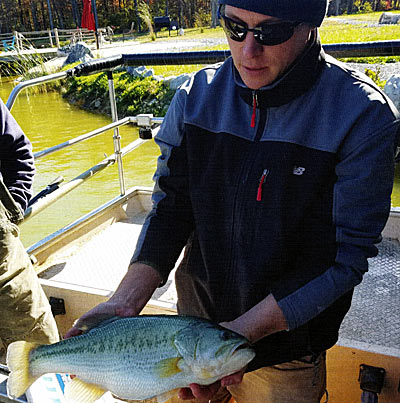
Pursuing your dreams is an incredibly gratifying experience that has a way of bringing out the best in yourself. For some of us, that involves creating a fishery where kids and adults alike can spend time together bonding in the essence of nature. Spending a day on the water with loved ones, in pursuit of the next trophy fish that family and friends will be talking about over dinner or around a campfire, can provide just enough motivation to keep someone from settling when it comes to building the pond of their dreams.
As you may recall from the story "Building the Fishing Pond of Your Dreams" in the May/ June, 2016 issue of Pond Boss magazine, a Virginia landowner left little to chance in his pond building process. His attention to detail was a calculated decision that provided him with great odds of achieving his goals. After years of doing his due diligence to purchase the right property, as well as properly construct the pond, the building phase was completed and the waterbody was starting to fill. It was the fall of 2015, and up to that point, the owner's hard work and patience had paid off.
Developing a high-quality fishery comes with a high risk of failure. Although this landowner did an outstanding job buying the correct property, as well as constructing what appeared to be a great pond, he was still several years away from understanding how successful the project would be. This lack of certainty, teamed with his passionate desire to reach his goals, motivated him to minimize assumptions and make good decisions.
Fast forward to the spring of 2016. Water temperatures were beginning to rise thanks to the warm southern winds, and the pond was prime to become a productive fishery. Golden Shiners and Fathead Minnows were stocked in April to help the forage base establish. To provide the forage with exponential growth, the pond was fertilized to produce a plankton bloom. Using a Secchi disk, the owner monitored the bloom and added additional fertilizer as needed. Using two automatic fish feeders, over one and a half tons of fish feed was fed to the forage base that first summer. To help support the productivity from the fertilizing and feeding program, a bottom diffused aeration system was also installed.
The first year the pond was on a fertilizing program, we took a slightly less aggressive fertilizing approach, and developed and maintained a bloom of approximately 24 inches. Much of this relaxed fertilizing approach was related to a slow leak that was discovered near the pond's outflow. When building the pond, the clay soil around the bottom drain outflow pipe was not sealed as well as necessary. As a result, the head pressure of the pond at full pool, teamed with a slight drought, made it obvious that the pond was leaking.
A leaking pond was not part of the dream for this landowner, and resolving the leak was paramount. Since the location of the leak was known, the best solution, in this case, was to add a slurry of bentonite to the water in that specific area of the pond. After two applications and less than a pallet of bagged bentonite, the golf ball sized leak sealed up tight, allowing the owner to sleep a bit easier.
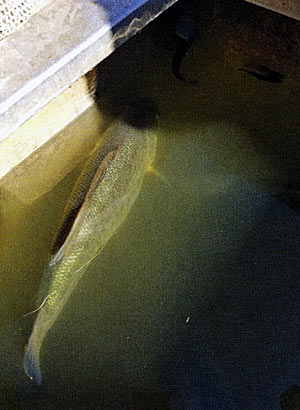
Based on the owner's goals and his willingness to be patient, the plan was to let the forage base establish for an entire year prior to stocking Largemouth bass. Although waiting an entire year is not necessary for all landowners, there are times when it is advantageous. The benefits to waiting an entire year can include the production of more forage fish per acre of water. Additionally, when growing species such as golden shiners, the additional time helps them to achieve a larger size, which can cater to the forage needs of bigger Largemouth bass.
A notable downside to waiting a year is the vulnerability to Mother Nature, who always seems to be waiting to take advantage of a pond full of forage fish. During the first growing season at this site, in particular, the owner dealt with water bugs, frogs, blue herons, great egrets, king fishers and cormorants—all trying to take advantage of the abundant forage base. Since this owner was building a home within a hundred feet of the pond, he was in a position to keep a close eye on the fishery and ensure that the forage base was on track, and mitigate the predation issues as they arose.
For the entire growing season of 2016, the pond maintained a high-quality plankton bloom and fish feeders fed an aggressive amount of high quality fish feed. By that fall, the forage base had reached a significant biomass. Throughout the water column, and across the entire pond, you could visually see forage fish everywhere you looked.
With the forage fish on track, it came time to decide what type of Largemouth bass to stock. The owner had two good options. One option was to stock rapid-growing fingerlings in the early summer of 2017. Rapid-growing fingerlings have the greatest chance to reach their full potential, in part, because they would grow faster in the owner's pond than they would at a fish hatchery, since fish hatcheries grow their bass at much higher densities with less available forage. A second option would be to stock an all-female population. All-female populations are desirable because they give the owner more control over the numbers of predators, and, as result, help reduce assumptions made when managing the fishery. The downside to all-female populations is that most female bass are grown at relatively high densities at a hatchery, and often do not reach their full size potential.
Despite the limitations some owners can experience when stocking all female bass, this stocking strategy best met this particular pond owner's goals of regularly catching five-pound bass when fishing—and having the potential to catch bass in the eight-pound range.
Thanks to the heavy biomass of forage fish, 24-month-old all-female bass were stocked at a relatively heavy rate of 40 fish per acre in the spring of 2017. They were grown on fish feed in the hatchery for the first two years of their lives and averaged one and a half pounds each when stocked. Using GoogleEarth, we accurately determined the owner's pond was four acres and required 160 female bass.
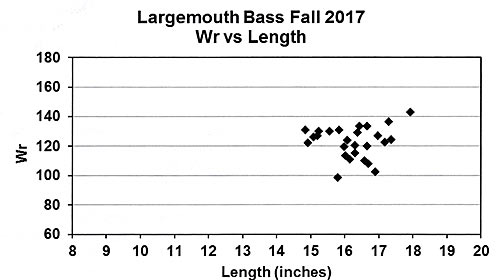
In October, just six months after stocking the bass, the fishery was electrofished to better gauge what was going well, and what was in need of attention. To the owner's enjoyment, the bass averaged three pounds, with an average growth rate of one and a half pounds per bass, or a quarter pound of growth each month. The average relative weight (Wr) was 123, and average length was 16.2 inches. The top performing bass recaptured weighed 4.7 pounds and was 17.9 inches long. The bass looked great and the owner is currently on track to achieve his long-term goals.
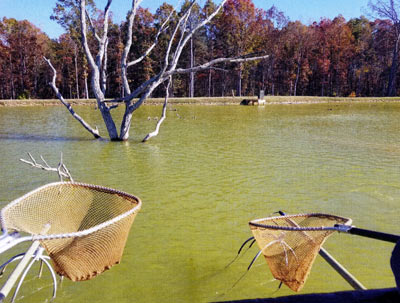
Based on the recent positive results and high odds of success, the owner now has the option to take his foot off of the gas and let his bass growth rates slow. This get to where you are going as fast as possible management approach, followed by the opportunity to coast for five to seven years, is an incredibly effective approach to creating an action-packed fishery for friends and family, while still meeting a realistic budget. For those with additional discretionary income, as well as loftier goals, fish growth can continue to be pursued at an aggressive rate throughout the life of your bass to provide anglers with access to truly exceptional fish.
Although this owner's pond is doing great, it still has challenges that it must overcome, as expected. The aquatic vegetation that was planted two years ago has struggled to establish. Attention needs to be given to the aquatic plants so that the forage base has a better source of refuge. Getting the aquatic plants to establish will also help improve the angling experience, since fishing through or around vegetation can add another layer of enjoyment to the fishing experience of an avid fisherman.
The most disappointing issue the fishery is currently facing is the presence of green sunfish. At some point over the past two years, green sunfish entered the waterbody and have successfully spawned. Based on the watershed, the sunfish most likely entered from upstream. Eradicating them from the system is not practical based on their numbers, but with some active management their numbers can be suppressed.
Despite these hurdles, hard work and dedication have started to pay off for this particular land owner. He set the bar high, and then pursued his dream, regardless of what others thought of his big ideas. Looking back at the process, it is incredibly gratifying to see someone work hard for several years to achieve a goal. Although the process has taken around five years from the time he started searching for the right property, he is in a great position compared to where he might be if impatience took over. If he had instead opted for the easy route, he could have purchased the wrong piece of land or bought a property that already had an existing, yet broken fishery. With a bright future ahead, and much of the hard work behind him, this pond owner can start spending quality time fishing with family and friends in a setting that will hold a special place in their hearts for generations.
Reprinted with permission from Pond Boss Magazine

